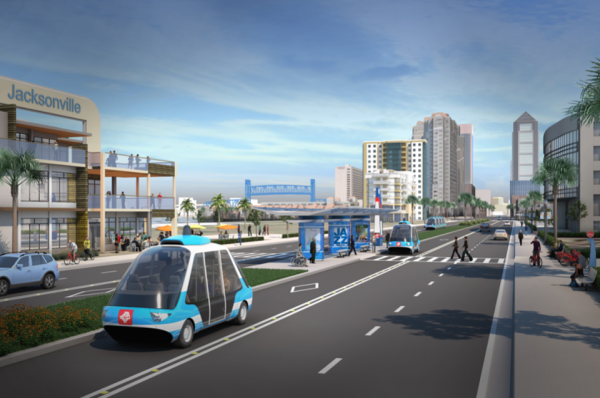Jacksonville’s Journey In Engaging With Autonomous Vehicle Technology – Forbes

Concept Picture for Ultimate Urban Circulator
Jacksonville Transportation Authority
While there has been a great deal of Autonomous Vehicle (AV) activity in the public eye related to private vehicles, such as robo-taxi tests from companies like Waymo or Uber, the City of Jacksonville has been charting its own course through the Jacksonville Transportation Authority (JTA) with the deployment of AVs for public transportation. The JTA’s engagement with the technology provides insight into the challenges and reality of implementing AV technology for public use in a production environment.
Disclosure: The JTA and the Advanced Mobility Institute at Florida Polytechnic University have a collaboration agreement. I initiated and built the Advanced Mobility Institute at Florida Polytechnic University.
The Opportunity: The JTA, a mid-size transit agency that began as an expressway authority, has operated an automated elevated people mover called the Skyway Express (Skyway) since 1989. At 2.5 miles, it serves the core downtown district. With the city’s population projected to continue to increase, the public transportation challenge now included connecting newly developed neighborhood centers, such as the entertainment and hospital districts. With the aging infrastructure and obsolescence of the vehicles, the JTA determined that it was the perfect time to consider AV technology as an compelling upgrade to the system.
Autonomous Vehicle technology had all the characteristics to provide a viable and cost-effective solution to converting the Skyway network without substantial infrastructure changes. Through a task force assembled in 2015 with various JTA, City of Jacksonville, business and community stakeholders, the idea that AVs could reuse the old Skyway civil infrastructure and then transition onto existing surface streets to extend the network took hold, and with this vision, the Ultimate Urban Circulator (U2C) project was born.
“When I arrived in Jacksonville in 2012, the first question I often got was ‘Nat, what are you going to do with the Skyway,’ and so we began to look at the possibilities almost immediately,” said JTA Chief Executive Officer Nathaniel P. Ford Sr.
The promise is great, but AVs are an emerging technology with many open questions. Can AV shuttles handle mixed traffic? Will they require dedicated lanes and, if so, will there be additional infrastructure investments? What will be the ongoing maintenance requirements? Will the vehicles still need drivers? Finally, who will provide the answers to these questions?
“These are still questions we’re working to answer, now, as part of our aggressive testing protocol in Downtown Jacksonville,” said Ford.
For public transportation entities, the traditional operating model is to engage with a large network of civil engineering firms through the procurement cycle, but would transit staff have the expertise to put together a Request for Information and if so, would traditional civil engineering firms even have the capability to credibly offer a solution in response?
“We determined very early on that we needed to bring in people who did not come from the traditional public transportation industry, because this is not a traditional public transportation industry endeavor,” said Ford.
“So we brought in Bernard Schmidt as our Vice President of Automation along with Michael Feldman as Director of the U2C Program,” Ford said. Both Schmidt and Feldman came to the JTA from Amazon where they specialized in robotics and automation.
Familiar with new technology introduction, the U2C team started by building a test facility (an isolated road in Downtown Jacksonville) upon which they could test vendor solutions. This was wise because they soon discovered there was a big difference between the demo-like capabilities presented by the AV vendors and the robust solution required by a public transportation utility. To resolve these issues, the U2C team works with vendors in an unusual research and development level collaboration. Understanding the criticality of the test and learn program and vendor relationships, a local governance structure was established and dubbed as the Bay Street Innovation Council (BSIC). The BSIC was initiated to bring key government stakeholders to the table to reach alignment on the U2C program and overall execution.
Given a relatively robust AV, the next task was to understand all the interesting use-models. Should there be a driver? What about access for the disabled? What about maintenance and energy? Since there were no precedents, each of these topics had to be investigated and solutions built. One major area of concern was to ensure that the JTA provided excellent customer service and a safe environment for riders to experience.
One of the most challenging issues was the topic of safety and certification. Another was integration with first responders. In 2019, the JTA hosted the first Northeast Regional First Responders Training for Autonomous Vehicles. The first responder training event set the groundwork where the JTA then launched a First Responder Council, bringing local law enforcement and the first responder community together to help refine the U2C strategy moving forward.
All of this work was done under the legal framework provided by the series of forward looking State of Florida AV bills spear-headed by Sen Jeff Brandes and Rep Jason Fisher. The latest one, HB 311, was signed by Florida Gov. Ron DeSantis on June 2019. Overall, the JTA’s U2C project demonstrates the complexity of introducing AV technology and the unique capabilities that an early pioneer must possess in order to engage in this space.






